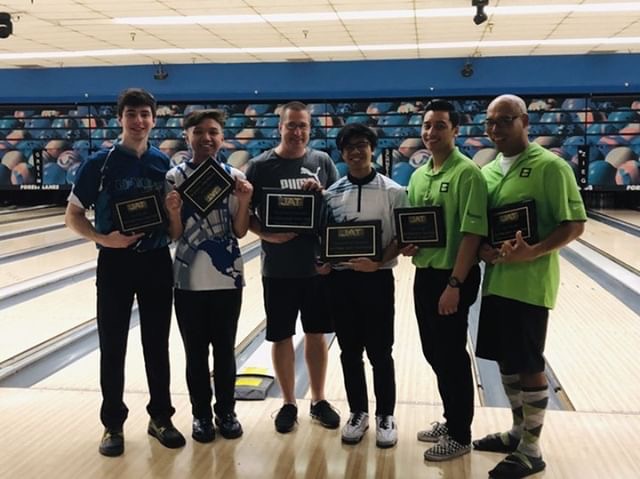Former junior bowlers, Anthony Schanen and Kevin Banaag (left), receive plaques for winning second place in a JAT doubles tournament.
The competitive side of bowling
March 26, 2019
“To me, bowling is more than just a sport,” said former junior bowler, Trevyr Geronimo. “It is also a course of new experiences that make you a better individual.” For three years, Geronimo bowled in the junior league at Jewel City Bowl, a bowling alley in Glendale. He now strives to compete professionally.
When it comes to hobbies, many people consider bowling as a recreational activity only played to celebrate special occasions or just to have fun. However, considering the degree of difficulty along with excellent hand-eye coordination required, bowling should also be thought of as a professional sport.
Bowling dates back to ancient Egyptian time, close to 5,000 B.C.E. It began as an activity with the objective of knocking objects over with stones. Additionally, in the Roman Empire, a similar game was made and later became Italian Bocce, or outdoor bowling. There are many variations of the game including nine-pin bowling, five-pin bowling, candlepin bowling, and duckpin bowling. Over time, the sport had evolved and grown more popular. Today, 100 million people, with 70 million being in the United States, play traditional ten-pin bowling.
Around the world, adults and children participate in leagues in many different bowling alleys. In fact, during the 1960s and ’70s, bowling centers received 70 percent of their income from league bowling. Through recent decades, league bowling began to decline, but it is still fairly popular today.
At most bowling alleys, league bowlers are often seen on the lanes. Every week, bowlers bowl with their team, hoping to win against their opponents. Similar to a tournament, these bowlers are competing for first place.

Trevyr Geronimo rolls his bowling ball while competing in a Junior Amateur Tour (JAT) tournament.
“I started bowling because my parents wanted me to try something new,” said Glendale High School sophomore and junior bowler, Jeremy Tuazon. “I didn’t enjoy it at first, but through the years I was able to improve and wanted to keep bowling.” Tuazon has been bowling in the junior league at Jewel City Bowl for the past seven years. Up to today, he has bowled two 300 games and continues to practice and bowl at tournaments.
Junior bowlers are often taught by coaches who have a lot of experience with the sport. With help from coaches and practice, bowlers can prepare for yearly tournaments, such as the state tournament.
Junior bowlers from all over the state sign up for this tournament. To represent their bowling alley, most bowlers wear matching jerseys with their names on the back. They are split in divisions based on their score average and participate in four events: team, doubles, singles and all event. By performing well in any event, bowlers can earn scholarship money for college.
Many tournaments are similar to the state tournament. However, not all tournaments will have the same events. Other tournaments, including Pepsi Youth Championships and the Junior Gold Championship, are much more complex and lengthy. The Pepsi tournament consists of ten games in two days. In addition, just the first part of the Junior Gold tournament is a five-day event.
Tournaments are frequently organized by bowling associations. Bowlers join associations for access to opportunities, tournaments, benefits and more. The United States Bowling Congress (USBC) is the national governing body of bowling. Other associations include the North Los Angeles County Bowling Association (NLAC) and Southern Los Angeles County Bowling Association (SLAC.)
“NLAC’s goal is to promote and grow the sport of bowling,” said NLAC association manager, Tom Leigh. Leigh provides supplies to centers and secretaries for memberships, the award program, scholarships, tournaments and fundraising for tournaments. With help from others, he also processes and presents information from committee meetings and hall of fame nominations.
USBC certified leagues work with Scholarship Management and Account Reporting for Tenpins (SMART) when it comes to scholarship. Each bowler is given a SMART account, in which any earned money is kept until the bowler turns 18.
Scholarship money helps youth bowlers with college tuition. Many colleges and universities in the US scout for bowlers that could potentially be on their women’s or men’s team. From 2017-2018, 154 schools sponsored varsity bowling teams.
Besides tournaments and scholarships, bowling is an equipment-heavy sport. Most people would just borrow a pair of shoes and a bowling ball from the bowling alley, but this is not the same for those who practice the sport professionally or seriously. An average bowler would need a ball that is fit to their hand along with a good pair of bowling shoes. To hold all their equipment, they would need a bag or locker.
“Bowling is both time and money consuming,” Geronimo said. “I am forced to balance out my school and work schedule while also being mindful with the money I spend.”
Additionally, bowling isn’t a sport that you can learn in a day or a week. It isn’t just throwing a ball and hitting some pins. There are many more technicalities in the sport than one can think of.
“I think bowling is unique as a sport,” said Hoover High School senior and former junior bowler, Kevin Banaag. “It requires so much precision and consistency that I don’t see in many other sports.” Banaag has been bowling for ten years. He isn’t bowling in the junior league anymore, but he competes in tournaments frequently. He currently works at Jewel City Bowl.
Bowling has many key factors including timing, ball release, footwork and oil pattern. Understanding concepts like these can help a bowler improve their physical and mental game. Although people have many different opinions about the sport, it cannot be disproved of being competitive, detailed and technical.
“Bowling helps me feel relaxed and have no worries,” Tuazon said. “I love my teammates because they always cheer me on no matter what. They’re like family to me.”
